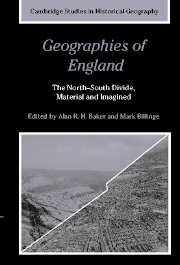Book contents
- Frontmatter
- Contents
- List of figures
- List of tables
- List of contributors
- Preface
- 1 Material and imagined geographies of England
- 2 The contemporary debate over the North–South divide: images and realities of regional inequality in late-twentieth-century Britain
- 3 Distressed times and areas: poverty, polarisation and politics in England, 1918–1971
- 4 Industry and identity: the North–South divide and the geography of belonging, 1830–1918
- 5 Divided by a common language: North and South, 1750–1830
- 6 South, North and nation: regional differences and consciousness in an integrating realm, 1550–1750
- 7 North–South dichotomies, 1066–1550
- 8 Cultural constructions of England's geography and history
- References
- Index
- Cambridge Studies in Historical Geography
7 - North–South dichotomies, 1066–1550
Published online by Cambridge University Press: 10 December 2009
- Frontmatter
- Contents
- List of figures
- List of tables
- List of contributors
- Preface
- 1 Material and imagined geographies of England
- 2 The contemporary debate over the North–South divide: images and realities of regional inequality in late-twentieth-century Britain
- 3 Distressed times and areas: poverty, polarisation and politics in England, 1918–1971
- 4 Industry and identity: the North–South divide and the geography of belonging, 1830–1918
- 5 Divided by a common language: North and South, 1750–1830
- 6 South, North and nation: regional differences and consciousness in an integrating realm, 1550–1750
- 7 North–South dichotomies, 1066–1550
- 8 Cultural constructions of England's geography and history
- References
- Index
- Cambridge Studies in Historical Geography
Summary
Late-medieval England was a land of dichotomies. The most conspicuous were those between upland and lowland, dispersed and nucleated settlement, woodland and champion, weak and strong lordship, free and customary tenants and tenures, remoteness and proximity to major markets, and between the marches and the metropolitan core. Some of these contrasts were inherent in England's climate and topography, others sprang from deep-rooted human institutions such as field systems, manors, and property rights, while yet others derived from the centralising and differentiating forces of governments and commercial exchange. Many of these dichotomies had a strong north–south dimension but this does not necessarily mean that there was such a thing as a ‘North–South divide’ or that distinctions between the North and the South should be privileged above other spatial and regional differences. The strength and nature of these dichotomies also varied over time, depending upon whether centripetal or centrifugal tendencies were more to the fore. Any systems shift in the balance between these two tendencies was likely to heighten the tensions between core and periphery thereby giving rise to expressions of northern (and southern) consciousness (Jewell 1994). This is what seems to have happened at the close of the Middle Ages. It was then that the dichotomy between North and South in the medieval period was probably at its most pronounced.
- Type
- Chapter
- Information
- Geographies of EnglandThe North-South Divide, Material and Imagined, pp. 145 - 174Publisher: Cambridge University PressPrint publication year: 2004
- 4
- Cited by



